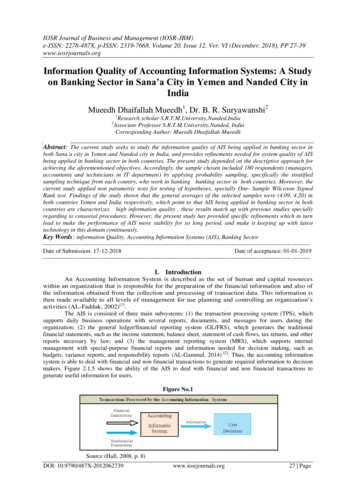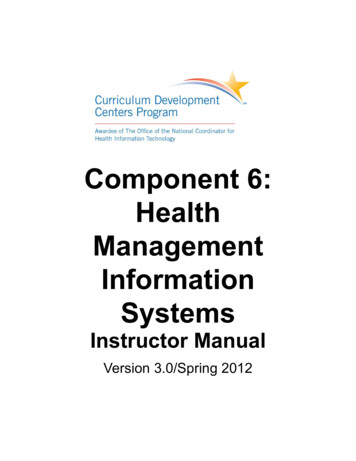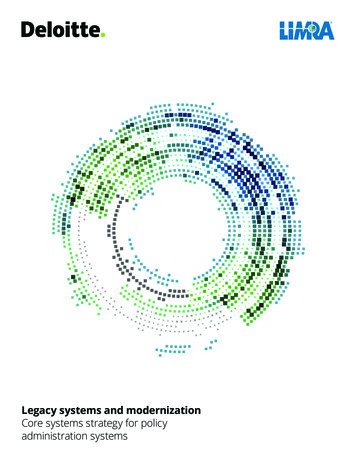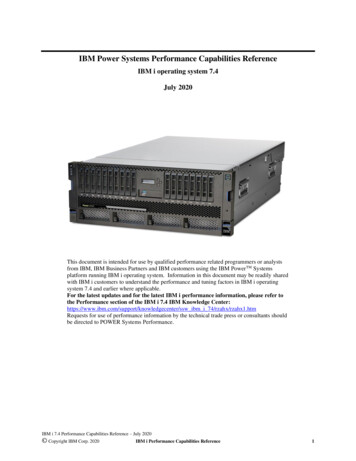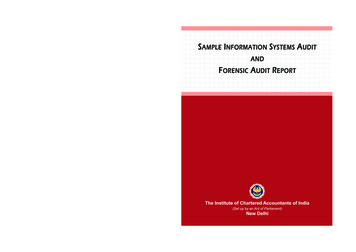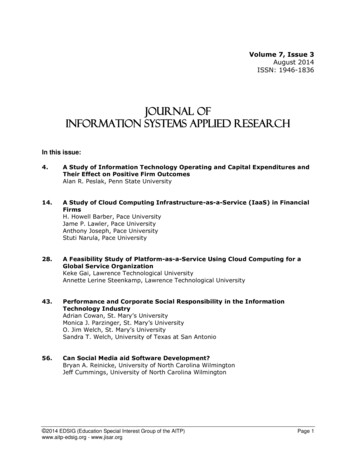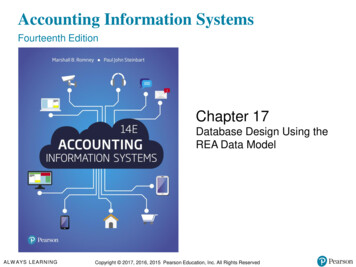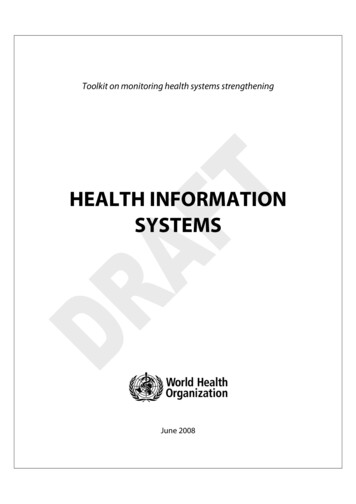
Transcription
Toolkit on monitoring health systems strengtheningHEALTH INFORMATIONSYSTEMSJune 2008
Table of contents1.Introduction . 22.Expectations of a country health information system. 33.Sources of information about the country health information system. 44.Criteria for assessing country health information system performance . 45.Methods for assessing country health information system performance . 76.Core indicators for country health information system performance . 8Health surveys .8Birth and death registration .8Census .8Health facility reporting.9Health system resource tracking.9Capacity for analysis, synthesis and validation of health data.97.Summary measure of health information system performance. 9Annex: selected tools .141
1.IntroductionSound and reliable information is the foundation of decision-making across all health system buildingblocks, and is essential for health system policy development and implementation, governance andregulation, health research, human resources development, health education and training, servicedelivery and financing.The health information system provides the underpinnings for decision-making and has four keyfunctions: data generation, compilation, analysis and synthesis, and communication and use. Thehealth information system collects data from the health sector and other relevant sectors,analyses the data and ensures their overall quality, relevance and timeliness, and converts datainto information for health-related decision-making.1The health information system is sometimes equated with monitoring and evaluation but this is tooreductionist a perspective. In addition to being essential for monitoring and evaluation, theinformation system also serves broader ends, providing an alert and early warning capability,supporting patient and health facility management, enabling planning, supporting and stimulatingresearch, permitting health situation and trends analysis, supporting global reporting, andunderpinning communication of health challenges to diverse users. Information is of little vale if it isnot available in formats that meet the needs of multiple users policy-makers, planners, managers,health care providers, communities, individuals. Therefore, dissemination and communication areessential attributes of the health information system.Health planners and decision-makers need different kinds of information including: health determinants (socio-economic, environmental behavioural, genetic factors) and thecontextual environments within which the health system operates; inputs to the health system and related processes including policy and organization, healthinfrastructure, facilities and equipment, costs, human and financial resources, health informationsystems; the performance or outputs of the health system such as availability, accessibility, quality and useof health information and services, responsiveness of the system to user needs, and financial riskprotection ; health outcomes (mortality, morbidity, disease outbreaks, health status, disability, wellbeing); and health inequities, in terms of determinants, coverage of use of services, and health outcomes, andincluding key stratifiers such as sex, socio-economic status, ethnic group, geographic location etc.A good health information system brings together all relevant partners to ensure that users of healthinformation have access to reliable, authoritative, useable, understandable, comparative data.1 Health Metrics Network Framework and Standards for Country Health Information Systems, World Health Organization, January 20082
2.Expectations of a country health information systemHealth information systems serve multiple users and a wide array of purposes that can besummarized as the generation of information to enable decision-makers at all levels of the healthsystem to identify problems and needs, make evidence-based decisions on health policy and allocatescarce resources optimally.2 Data from different sources are used for multiple purposes at differentlevels of the health care system. Individual level data about the patient's profile, health care needs, and treatment serve as thebasis for clinical decision-making. Health care records provide the basis for sound individualclinical care. Problems can arise when health workers are overburdened by excessive data andreporting demands from multiple and poorly coordinated subsystems. Health facility level data, both from aggregated facility-level records and from administrativesources such as drug procurement records, enable health care managers to determine resourceneeds, guide purchasing decisions for drugs, equipment and supplies, and develop communityoutreach. Data from health facilities can provide immediate and ongoing information relevant topublic health decision-making but only if certain conditions are met. The data must be of highquality, relate to all facilities (public and private), and be representative of the services available tothe population as a whole. Population level data are essential for public health decision-making and generate informationnot only about those who use the services but also, crucially, about those who do not use them.Household surveys have become a primary source of data in developing countries where facilitybased statistics are of limited quality. But household surveys are needed everywhere because theyare the only good source of information on individual beliefs, behaviours and practices that arecritical determinants of health care use and of health status. Public health surveillance brings together information from both facilities and communitieswith a focus mainly on defining problems and providing a timely basis for action. This isespecially so when responses need to be urgent, as in the case of epidemic diseases. The need fortimeliness of reporting and response, and the requirement for effective linkages to those inauthority with the responsibility for disease control, impose additional requirements on healthinformation systems.Recognition of the importance of health information systems capable of generating reliable data isgrowing. In many countries, health sector reform and decentralization have brought about shifts infunctions between the central and peripheral levels and generated new information needs withchanging requirements for data collection, processing, analysis and dissemination. Health sectorreforms also magnify the need for standardization and quality of information.Performance and results based monitoring, stimulated by unprecedented increases in developmentassistance and global health initiatives such as the GAVI Alliance, the Global Fund to fight AIDS,Tuberculosis and Malaria (GFATM), the U.S. President's Emergency Plan for AIDS Relief(PEPFAR), and the Roll Back Malaria (RBM) partnership, have increased pressure on governmentsand organizations to improve their performance and demonstrate tangible results to theirstakeholders. In this environment, a premium has been placed on the existence of adequate, quality2 Health Metrics Network Framework and Standards for Country Health Information Systems , Geneva, World Health Organization, 2008http://www.healthmetricsnetwork.org3
health information. Health information systems are called upon to enable tracking along thecontinuum of inputs to the health system, processes and outputs, as well as outcomes and impact.Few developing countries have sufficiently strong and effective health information systems to meetall these diverse information needs. New technologies can contribute to improving data generation,compilation and exchange but will require the existence of clear data quality standards to be ofoptimal value.3.Sources of information about the country healthinformation systemInformation about the functioning of the health information system can be obtained from thedifferent sectors and agencies that have responsibilities for the generation, synthesis, analysis and useof data at country, regional and global levels. At country level, Ministries of Health record thetimeliness and quality of data reported through health services and disease surveillance systems.National Statistics Offices maintain of information about the availability and quality of data generatedthrough major data collection undertaking such as the decennial census, large scale householdsurveys, and the civil registration system. As custodians of national official statistics, they often haveexplicit requirements for the way data are collected, compiled and shared, and adhere to theFundamental Principles of Official Statistics.3 International agencies working in health also maintaininformation about the availability and quality of data on international health goals, including but notlimited to the Millennium Development Goals.4.Criteria for assessing country health informationsystem performanceCriteria for assessing performance of health information systems and the quality of data they generatehave rarely been defined, let alone implemented. By contrast, in sectors other than health, andparticularly for macroeconomic and financial statistics, considerable work has been done to definestandards, guidelines and best practices (BOX).A commonly used standards framework is provided by the UN Fundamental Principles of OfficialStatistics. Data quality assurance approaches generally distinguish assessment criteria for data outputsfrom those that relate to the quality of institutional frameworks that are prerequisites for thegeneration of reliable data. Some of the quality frameworks are intended to be used to assess nationallevel data whereas others relate to the quality of data issued by international agencies such as theWorld Bank or the IMF.The Health Metrics Network (HMN) Framework identifies the key components and standards of acountry health information system.4 The Framework describes health information systemcomponents in terms of resources, indicators, data sources, data management, information products,3 United Nations. Fundamental principles of official statistics. New York, United Nations Statistics Division, 1994. Principles include impartiality, scientificsoundness, professional ethics, transparency, consistency and efficiency, coordination and collaboration.4 Health Metrics Network Framework and Standards for Country Health Information Systems , Geneva, World Health Organization, 2008http://www.healthmetricsnetwork.org4
and dissemination and use. The Framework lays out standards to be attained for each componentand describes data-management, transformation of data into useable information, dissemination anduse.Country information system performance can be assessed either through independent (oftenexternal) expert evaluation or using a self-administered tool (see matrix). Independent, assessment isgenerally based on existing sources such as databases of international agencies so as to minimize thereporting burden on countries. The disadvantage is that countries may not agree with the assessmentand therefore may not use the results for developing an improvement strategy. The major advantageof self assessment approaches are the degree of country ownership generated that enables theassessment to serve as the basis for the development of a plan for improvement. However, selfassessment approaches are generally time consuming and complex to implement and are less likely togenerate results that can be compared over time or between countries, and are likely to be biasedStatistical systemHealth informationsystemSelf assessmentIndependent assessmentGeneral Data DisseminationStrategyHMN self assessment toolWorld Bank Statistical Capacity-Building ScoreHIS performance index (HISPIX)Specific indicators - reporting rates, data andstatistics availabilitySelf-assessment approachesThe General Data Dissemination Strategy (GDDS)5 is designed to: assist countries in assessing and documenting their statistical practices and procedures andcompiling metadata; and, enable countries develop and implement plans for improvement in the different areas of statisticscovered by the GDDS.5 The International Monetary Fund (2997) The General Data Dissemination System: Guide For ParticipantsAnd Users IMF Washington5
BOXThe Organization for Economic Cooperation and Development (OECD) has developed statisticalstandards, guidelines, and best practices on development indicators.6 Explanatory metadata arecollected and published to accompany all data and thus enable users to assess data quality, i.e., fitnessfor use. Based on these metadata, comparability across countries an important aspect of dataquality can be assessed.Some national statistics offic
health information system collects data from the health sector and other relevant sectors, analyses the data and ensures their overall quality, relevance and timeliness, and converts data into information for health-related decision-making.1 The health information system is sometimes equated with monitoring and evaluation but this is too reductionist a perspective. In addition to being .File Size: 425KBPage Count: 19
